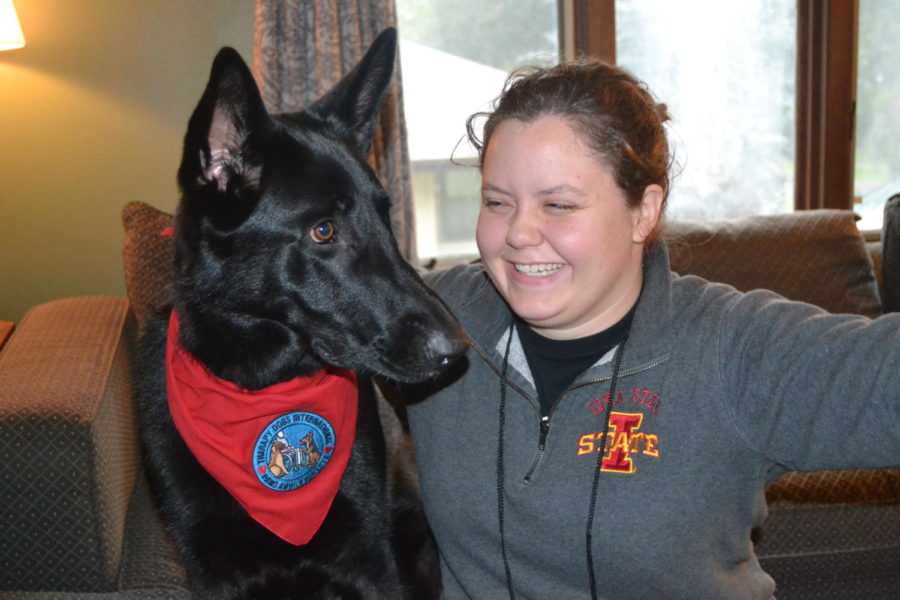Animal Helpers
How animals help people in their day-to-day lives
October 20, 2017
For many people, pets have been a part of our lives for our whole lives. They’ve been our companions through good times and bad. Pets help reduce stress better than our human companions. Pet owners had less stress and quicker recovery from stress when they were with their pets as compared to when they were with their spouse or friend. But some need more support than others… insert animal therapy.
Pet therapy is a growing field that uses dogs or other animals to help people recover from or better cope with health problems. Studies show that being around animals, like dogs can lower cholesterol, heart disease, and the chances of obesity.
“I recently just left my job as a teacher and we’ve trained Lina very well, and I loved having her my first year of teaching which was full of stress and anxiety and lots of things and she helped me a lot with that. I wanted to use her to be a “bright light” to someone’s day and help them like she did to me,” Emily Foster said. Foster’s German Shepherd, Lina is a certified therapy dog. She takes Lina to retirement homes and hospitals to comfort those in need. She eventually hopes to be able to bring her dog to schools but is difficult due to the fact that schools need to apply in order to have them come. “As a larger dog, she would be a demonstration on how to interact with big dogs. Most kids see them as guard dogs and as scary and intimidating. I want to show them how to be around a big dog and not all of them will bite,”.
The use of therapy animals dates back all the way to World War II, when a little Yorkshire Terrier named Smokey who would accompany nurses at a hospital in New Guinea and would comfort the troops there. Smokey was so successful there that she continued her work for 12 years, even after the war ended.
It’s not just dogs that are top therapy pets, they may be ranked number one but there are many more species that are right on their tail. Such as, rabbits, guinea pigs, and other possible rodents. They are popular for their small size and the fact that their easy to handle. Pigs are also pretty popular along with horses, even though they might not as common as dogs but they are just as beneficial.
“There are so many ways horses can help you, just being outside and in nature is an experience lots of inner city kids don’t really have, some had never been on a farm or been around animals. There are the proven benefits of Hippotherapy,” Deb Hoyt, owner of “Healing Hearts with Horses” said. Healing Hearts with Horses was a program working with foster, adoptive and at-risk children and youth. We provided Equine Assisted Psychotherapy and Hippotherapy to youth and children in need. They are both proven therapeutic interventions. Sadly, this program is closing but besides that, programs like this help so many people from all types of situations.
Many people claim that their pet is a “therapy animal” but even though they are there for comfort and support, therapy animals have a much larger task at hand. The Americans with Disabilities Act (1990) define “service dog” under its broader definition of “service animal”. “Service Animal” (ADA Subsection 36.104): “Any guide dog, signal dog, or other animal that is individually trained to do work or perform tasks for the benefit of an individual with a disability, including, but not limited to, guiding people with impaired vision, alerting people with impaired hearing to intruders or sounds, providing minimal protection or rescue work, pulling a wheelchair or fetching dropped items, alerting.”
Almost any animal (dog) can be a service dog, but the main requirement is that the dog must be able to provide a service for the disabled person that they would have had a difficult time doing without the service dogs. Service dogs wear a special cape or insignia to inform people to not distract the dogs from their “jobs” when they are working.
There are certain criteria that you have to meet in order to be able to possess one of these animals. For example, severe learning disorders, ADD/ADHD, motor skill disorders, bipolar disorder, substance-related disorder, cognitive disorders, etc. You cannot just go to your doctor and say “hey, so I have anxiety, can I have a service animal?”. It doesn’t work that way. If you choose to apply for an animal, your letter must include a current patient signing by a mental health doctor, under this mental health professional care
and treatment of your disability which is
described in the Diagnostic and Statistical
Manual of Mental Disorders substantially limited in performing in at least one of life’s major events because of your disability.
If you are interested in getting one of these animals, talk to your doctor to make sure this will benefit and not just because you want one and if they say okay, make sure to follow all the rules and criteria and make sure you research them before you make this decision.

